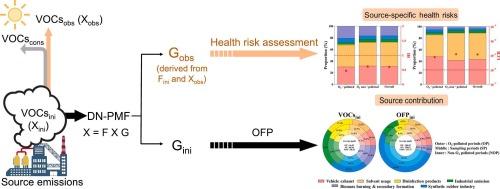挥发性有机化合物光化学损失的影响:来源分配、臭氧形成潜力和健康风险评估的综合方法。
IF 8
1区 环境科学与生态学
Q1 ENVIRONMENTAL SCIENCES
引用次数: 0
摘要
近年来,臭氧(O3)浓度的增加引起了人们的广泛关注,但挥发性有机化合物(VOCs)带来的健康风险也不容忽视。由于挥发性有机化合物与环境空气中的氧化剂具有高度反应性,因此准确确定导致健康风险和臭氧形成的挥发性有机化合物的主要来源一直具有挑战性。本研究在台湾中部城区进行了VOCs的季节和日野外测量,旨在阐明VOCs光化学损失对O3来源分配的影响,以及不同O3水平下VOCs的健康风险。结果表明,O3的形成对VOCs很敏感,这是通过观察到的VOCs/NOX比值的区域阈值来诊断的,并且O3浓度与初始O3形成势之间存在显著的正相关关系。将分散归一化正矩阵分解模型应用于VOCs的初始混合比,确定了6种VOC来源,其中合成橡胶工业和溶剂使用是O3形成潜力的主要贡献者。制定了一种由来源决定的健康风险评估方法,将光化学损失的影响和观察到的挥发性有机化合物混合比例结合起来,从而能够更准确地评估来自不同来源的健康风险。与挥发性有机化合物来源有关的非致癌风险仍在可接受的阈值范围内,而车辆尾气和溶剂使用造成的致癌风险则高于可接受的水平,特别是在无O3污染的日子。该研究强调了建立VOCs和O3同步控制策略对有效缓解空气污染和改善公众健康的重要性。本文章由计算机程序翻译,如有差异,请以英文原文为准。

Implications of photochemical losses of VOCs: An integrated approach for source apportionment, ozone formation potential and health risk assessment
The increasing ozone (O3) concentration has received significant attention recently, yet the health risks posed by volatile organic compounds (VOCs) cannot be ignored. Accurately identifying the primary sources of VOCs contributing to health risks and O3 formation has been challenging due to their high reactivity with oxidants in ambient air. This study conducted field measurements of VOCs seasonally and diurnally in an urban area of central Taiwan, aiming to elucidate the effects of photochemical loss of VOCs on the source apportionment of O3, as well as health risks of VOCs under different levels of O3. The results revealed that O3 formation was sensitive to VOCs, which was diagnosed using the regional threshold of the observed VOCs/NOX ratio and was further supported by a significant positive correlation between O3 concentrations and initial O3 formation potential. The dispersion normalized positive matrix factorization model, applied to initial mixing ratios of VOCs, identified six VOC sources, with the synthetic rubber industry and solvent usage being prominent contributors to O3 formation potential. A source-attributed health risk assessment approach was developed that incorporates the effects of photochemical losses and observed mixing ratios of VOCs, enabling a more accurate evaluation of health risks from different sources. Non-carcinogenic risks associated with VOC sources remained within acceptable thresholds, while the carcinogenic risks posed by vehicle exhaust and solvent usage were above acceptable levels, particularly on O3 non-polluted days. This study highlights the importance of establishing concurrent control strategies for VOCs and O3 to effectively mitigate air pollution and improve public health.
求助全文
通过发布文献求助,成功后即可免费获取论文全文。
去求助
来源期刊

Science of the Total Environment
环境科学-环境科学
CiteScore
17.60
自引率
10.20%
发文量
8726
审稿时长
2.4 months
期刊介绍:
The Science of the Total Environment is an international journal dedicated to scientific research on the environment and its interaction with humanity. It covers a wide range of disciplines and seeks to publish innovative, hypothesis-driven, and impactful research that explores the entire environment, including the atmosphere, lithosphere, hydrosphere, biosphere, and anthroposphere.
The journal's updated Aims & Scope emphasizes the importance of interdisciplinary environmental research with broad impact. Priority is given to studies that advance fundamental understanding and explore the interconnectedness of multiple environmental spheres. Field studies are preferred, while laboratory experiments must demonstrate significant methodological advancements or mechanistic insights with direct relevance to the environment.
 求助内容:
求助内容: 应助结果提醒方式:
应助结果提醒方式:


